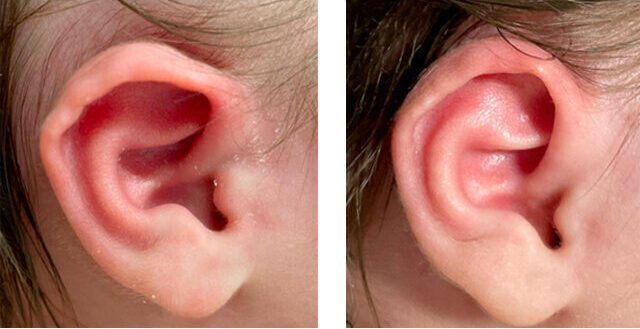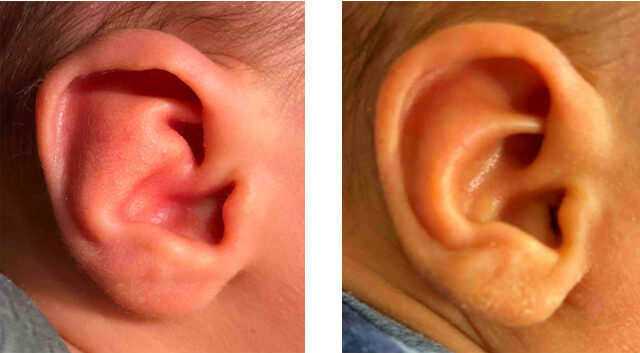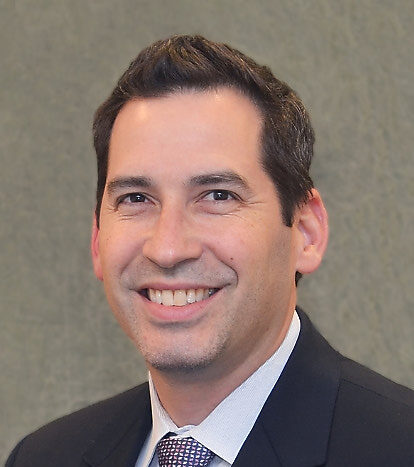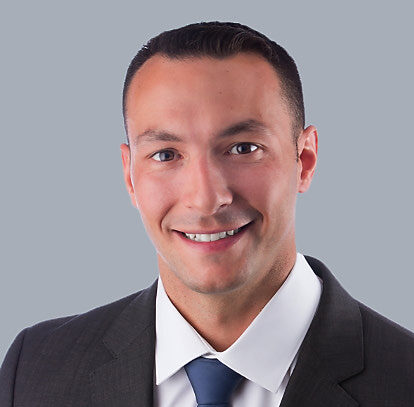Rather than waiting several years for a surgery to correct a child’s abnormally shaped ear, families can have their newborn’s ears repaired with a customized, painless treatment at Mass Eye and Ear.

Welcoming home a healthy newborn is a joyous occasion for any family. Yet, amid all the excitement and celebration, it can be easy to lose sight of the slightest imperfections on a child, no matter the size.
One common problem in newborns are anomalies of the ears. These imperfections may go unnoticed at first and can include abnormal folds, curls or pointed tips on the outer ear that, if not treated early enough, can harm the psyche and—in certain cases—the hearing of a child in the earliest stages of development.
Thankfully, a customized, painless ear molding intervention has helped parents correct such deformities without having to worry about surgery years later. At Mass Eye and Ear, pediatric ear, nose and throat (ENT) surgeons are working to familiarize families of newborns—as well as the doctors who care for them—with this non-invasive, early-intervention strategy. Their efforts are part of an ear molding program that was launched by Leila A. Mankarious, MD, 20 years ago and has remained active since.
Focus caught up with Dr. Mankarious; Michael S. Cohen, MD; and Louis F. Insalaco, MD to better understand why newborns with abnormally shaped ears should be evaluated for ear molding as soon as possible.
“What always gets me are the parents who come in a little too late,” said Dr. Insalaco. “Nothing feels worse than hearing them say, ‘I just wish I knew about these molds a little earlier.’”
A tight window for change
According to Dr. Insalaco, up to 20 percent of children are born with some type of ear deformity. Most parents might consider correcting a minor deformity for cosmetic purposes only, especially if the abnormal shape could subject their child to teasing from peers. Children who grow up with prominent or folded ears often struggle to shake a stigma attached to their appearance. According to Dr. Cohen, name-calling by peers and family members, even if intended as playful, can be harmful to a child’s self-image.
“Families often share that they have heard comments about their child’s ‘elf ears,’ or that abnormally shaped ears look ‘cute,’” Dr. Cohen explained. “While that may be seen as cute for a newborn, it might not be so cute for a grade-school student.”
Unbeknown to most parents, the shape of a child’s ear can also affect a child’s hearing. The many folds, bends and curves of the ear naturally amplify different sound frequencies. According to Dr. Cohen, abnormalities of the external ears can also be associated with problems deeper within the ear.
“It is important to consider whether further hearing testing is necessary in children with ear anomalies. This is something that we will evaluate and discuss during any ear molding consultation,” he added.
Complicating matters is a tight timeframe for fixing the shape of the ear without invasive surgery. For the first several weeks of life, a newborn’s ear cartilage is very malleable. By holding the ears in a corrected position within that time span, a pediatric ENT surgeon can easily correct the deformity in a matter of weeks. After three months, the cartilage in a newborn’s ears loses its malleability and ear molding is no longer possible. This means a child would need to wait until at least the age of five to correct the ear with a more invasive otoplasty surgery, which may require general anesthesia and a longer recovery period.
‘Braces’ for the ears
Unfortunately, ear molds are not a particularly well-known treatment option among families and pediatricians. While many ear abnormalities can correct on their own, most do not, and parents might wait too long to have their child evaluated.
“There are many families I see who are encouraged by their pediatrician to wait and see what happens,” Dr. Mankarious said. “But it’s important to know that most ears won’t significantly change on their own after the first one-to-two weeks of life.”
At Mass Eye and Ear, families with children who are candidates for the procedure can have their child fitted for molds the same day as their consultation. A pediatric ENT begins the process by assessing the architecture of the ear and determining—with the family—what should be corrected. If the family decides to proceed, the doctor will determine what type of custom ear-molding materials to use. Placement of the molds takes anywhere from 10-20 minutes per ear, depending on the complexity of the abnormality and the materials needed to correct it. Sometimes, a small amount of hair needs to be shaved in order for the molds to adhere properly.
The child must wear the mold 24 hours a day for two-to-six weeks. In collaboration with the family, the doctor will decide when molding is complete.
“Think of it like a child who visits the dentist with an overbite or crooked teeth,” Dr. Insalaco added. “Just as a dentist might use braces to straighten teeth and hold them in a corrected place, we’re using molds to hold the child’s ears in place.”

Keeping infant ear care accessible
Despite the growing popularity of ear molds, few ENT providers have the training or resources needed to offer the treatment in their clinics. Mass Eye and Ear, however, has proven an exception. Not only do its specially trained clinicians have the necessary expertise and equipment, but they are committed to making the highly specialized treatment accessible outside Boston and in suburban communities.
At the hospital’s Stoneham location, Dr. Insalaco uses EarWell technology to make molds in his clinic, allowing families on the North Shore to forgo a long trip into the city for a consultation.
Additionally, Dr. Cohen, who serves as director of the Pediatric Otolaryngology Fellowship at Mass Eye and Ear, emphasizes the treatment option among pediatric ENT trainees at the hospital. The more the treatment is practiced, he insists, the more likely clinicians and families can expect to see extraordinary outcomes and avoid future surgeries.
Both developments, Dr. Mankarious said, should give families plenty of reason for excitement.
“In medicine, we’re always looking to find new ways of limiting the invasiveness of the care we provide,” she said. “As new technologies and techniques for creating ear molds emerge, I’m confident our program at Mass Eye and Ear will continue to be at the forefront of providing treatments that limit the burden of ear care years later.”



I would like to know if you work with the infant ear model(earwell)(protruding ear) for a 3 month old baby. Does My insurance cover this? Thank you, I appreciate the contact.
Hi Lillyanne, that question on insurance coverage is bet answered by the office, please contact the Pediatric ENT group at 617-573-3190.